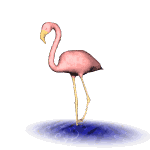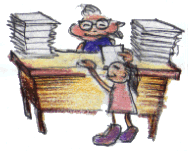 Trip
Delayed.
Trip
Delayed.
A WebQuest for 7th Grade English Language Arts
Designed by
Rhonda Smith
x99eqh@stfx.ca

Introduction | Task | Process | Evaluation | Conclusion | Credits | Teacher Page
 Trip
Delayed.
Trip
Delayed.
Designed by
Rhonda Smith
x99eqh@stfx.ca

Introduction | Task | Process | Evaluation | Conclusion | Credits | Teacher Page
![]()
Congratulations! You are an award winning author, who has made millions of dollars for your last three books. But before you pack your bags and head to St. Kitts (a tropical island in the Carribean with low taxes), you have to fulfil your contractual obligations. You still have to write one more story for your publisher. This is unfortunate because you are experiencing a slight case of writer's block. You know that you are going to need some help to finish this story. Luckily, you have great writer friends, who would be more than happy to help you. You happily begin your journey through the writing process.
 Pages
on the Writing Process
Pages
on the Writing Process
 Editing
Tips
Editing
Tips
 Back to the top of the page
Back to the top of the page
Rubric for Creative Writing
| Item to Be examined | A Gleam in a Publisher's Eye 4 | Almost Ready for Publication
3 |
A Work in Progress
2 |
A Gleam in Your Eye
1 |
| Sparks Interest | Captures reader's attention from first riveting sentence, paragraph, or line; reader cannot help but continue | Gets reader's attention with first sentence, paragraph, or line, drawing reader into rest of piece. | First sentence, paragraph, or line lacks dramatic tension necessary to draw reader into piece; reader may not keep reading | First sentence, paragraph, or line lacks dramatic tension necessary to draw reader into piece; reader may not keep reading. |
| Tools of Writing Short Stories | Dazzles reader from beginning to end through original and interesting use of ideas, language, plot, character development, dialogue, imagery, etc.Contains no clichés or stereotypes. | Interests reader most of the way through the piece because of mostly original | Offers little originality in ideas, language, plot, imagery, etc. May contain many clichés and/or stereotypes. Reader may lose interest. | Lacks originality in ideas, language, plot, |
| Clarity and Involvement | Although challenging and perhaps not easily understood, work has a clarity that leaves no surface questions (i.e. "What happened in this part?") in reader's mind. | Has a clarity that leaves few surface questions (i.e. What happened in this part?") in reader's mind. | Leaves several surface questions (i.e. "Why is the character named Myrtle on page 1 and Jill on page 4?") in reader's mind. | Is downright murky because of significant and unintentional gaps or contradictions in logic, plot, character, imagery, voice, point of view, setting, etc. |
| Mechanics | Contains no errors in grammar, usage, or mechanics (unless used for artistic purposes) | Contains few minor errors in grammar, usage, or mechanics (aside from those used for artistic purposes) | Contains many and/or serious errors in grammar, usage, or mechanics; may interfere with reading. | Contains so many errors in grammar, usage, and mechanics that errors block reading. |
Congratulations! You have just finished
your journey through the Writing Process. You have finished your
contractual obligations. Pack your bags and head to St. Kitts.
Enjoy the sunshine and the relaxation. I'm sure that this story will
be a best seller. Keep in mind that you will eventually run out of
money. Perhaps you can think of some ideas while you are on vacation.
Here is a site that could provide helpful ideas on what to write.
Here is a site that will enlighten you on
what other writers have to say about writing. Perhaps you can quote
these authors in the interviews you will be asked to do after the release
of this story. Write a short response to the question, "How do you
feel about writing?", quoting another author.
List here the sources of any images, music or text that you're using. Provide links back to the original source. Say thanks to anyone who provided resources or help.
List any books and other analog media that you used as information sources as well.
Rubric Adapted From: Rubric for Creative Writing